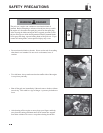
2222
2222
22
C. With most needled evergreens, pruning is confined to
trimming back a portion of new growth to control height or
spread, or to even the shape. Pine growth tips (commonly
called candles) can be cut back from one-third to three-
quarters prior to the time the needles of the candles unfold.
The growth tips of spruce and fir can be trimmed back by as
much as three-quarters while the shoots are still tender and
flexible.
TECHNIQUE
When trimming shrubs and hedges, there are two approaches. One
involves pruning away old wood to induce new shoots and growth;
the other involves clipping or trimming the shrub to reduce its total
height. Small-leaf, close-textured shrubs respond well to repeated
clipping and make the best formal hedges. Larger-leaf, open shrubs
are better suited for pruning and not trimming with a hedge clipper.
When operating hedge shears or clippers, hold the cutting blades
parallel to the surface you’re trimming, and cut back to the point
where you’ve previously sheared. By starting low and working your
way up, it makes it easier to trim the top part of the hedge. Tools like
ECHO’S new shaft hedge trimmers help to extend reach while the
articulating hedge trimmer makes sculpting a breeze and facilitates
reaching across the top of taller hedges while still maintaining a
parallel cut.
When the trimming project is done, remove the bulk of the clippings,
but don’t worry about the few that remain on top of the hedge or
that fall within its borders.
In a few days they will shrivel up and die.
PRUNING DO’S AND DON’TS
Two common practices are particularly harmful to trees and should
be avoided at all costs.
• One is referred to as topping, the indiscriminate heading of large
upright branches to reduce the height of a tree.
• The other is called tipping, the cutting away of lateral branches
to reduce crown width.
Both practices not only leave behind an unsightly tree, they also
inflict damage that will kill the remainder of the cut branch and quite
possibly cause additional tree stress.
Still, one of the most common ways trees are injured is to simply not
follow recommended pruning practices that needlessly rip away bark
or otherwise leave trees susceptible to insects, disease and decay.
Also, latest research has shown that painting tree wounds is not
necessary. Trees develop their own barriers to seal off damaged or
freshly pruned tissues.
Routine pruning is vital to the health of all trees and shrubs. When
done properly, it will work to maintain health, vigor and beauty and
help ensure these landscape elements deliver years of trouble-free
enjoyment to property owners.
PRUNING: TIMING AND TECHNIQUE


















